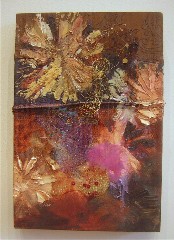
One of a group of paintings on stitched-together pieces of upholstery fabric, by Tattfoo Tan
Since Tattfoo Tan’s last exhibit at Peng Gallery (see Roberta’s post here), he got a big write-up in the New York Times that made him sound like the next new wave. Tan’s outpost in Staten Island, which serves as home for himself and his wife and their various, art-related enterprises looked breathtaking and challenging all at once in the photographs.
With that aura of media-darling success, Tan returns to Peng Gallery with his exhibit, PONDering.
Tan, who came to this country from Malaysia, uses industrial sized coffee filters stacked and strewn across the floor, paintings of bamboo, abstract impressionism (is there such a thing?)with poured resin and glitter over paint, and, my favorites, explosive chrysanthemums of paint on stitched together strips of upholstery fabric.
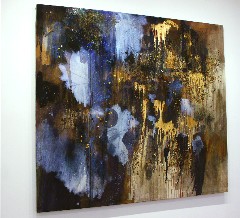
by Tattfoo Tan
The abstracts, which made me think of Monet’s water lily paintings crossed with Helen Frankenthaler and Jackson Pollack, are utterly beautiful. I like the shamelessness in the use of sumptuous materials like glitter and resin. I like the pools of color and the gestures. This work reminds me a bit of Antonio Puri’s chilly confections which also use a variety of materials, including beads and resin and layers of this and that, but Tan’s retain more exuberance and warmth. Even so, I felt like there was something glib here.
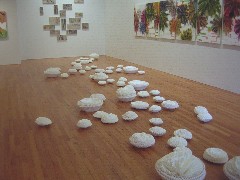
PONDering
And while I admired the wit and edginess of the coffee filters as water lettuce floating on a floor pond, in PONDering, I wasn’t sure why coffee filters made philosophical sense as leaves floating on water. Is coffee the anti-tea? I did enjoy tiptoeing through, however.
On the other hand, the series of chrysanthemum-like explosions on the stitched upholstery fabric stole my heart for the happy marriage of content and materials (see top image). The prominent red stitching in some of these is a statement about the struggle to join disparate materials. Some of the stitching seemed to sew up scars or create scars. The colors–the splotches of hot pink, the trowelled-on yellows of the explosions over the warm browns–mix surprise and expectation. These paintings give back something close and something from afar. They seduced and refused to seduce all at once. And the fabrics and stitching of the support set up an argument between decoration and meaning, paint and pattern. These were terrific.
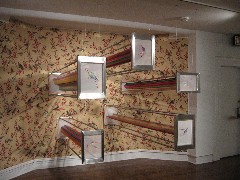
Here and There installation by Xiang Yang
Another Asian-born artist working to join his new environment to something meaningful from his past is Xiang Yang, one of the artists in the group mural show OUTsideIN at the Philadelphia Art Alliance (see Roberta’s post here which has links to both our Flickr photo sets).
Xiang is also stitching. When I look at his work, I think of all the Chinese workers embroidering blouses and napkins and tablecloths for the Western market. The long columns of embroidery threads that stretch behind the framed embroidery images link the stitched birds (and the coupling lovers) to the wallpaper birds behind them. The wallpaper looks to me like the Victorian adaptation of chinoiserie for home decoration.
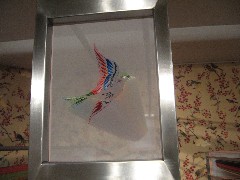
embroidered bird detail from Here and There
The superstructure of the frames that enable Xiang to stretch the embroidery over space is less intrusive than it was in his show at Pageant (see posts here and here), although it’s still a bit of a distraction. But all in all, I am finding Xiang’s work increasingly satisfying and interesting.









